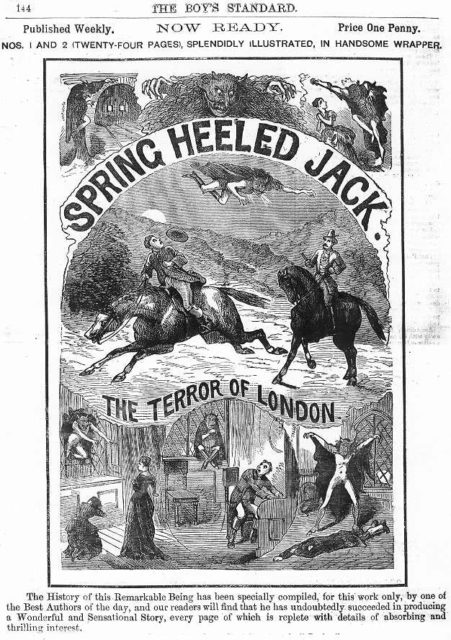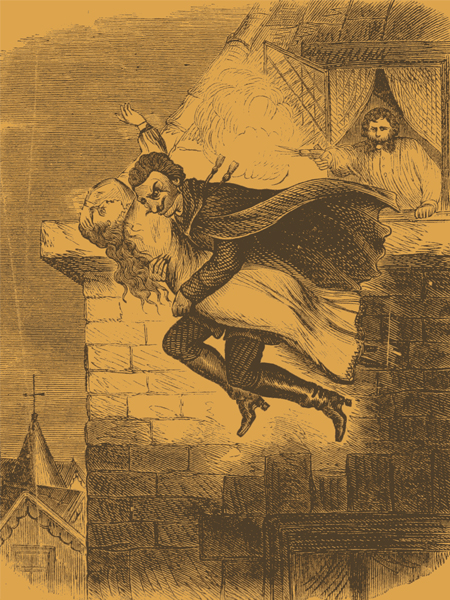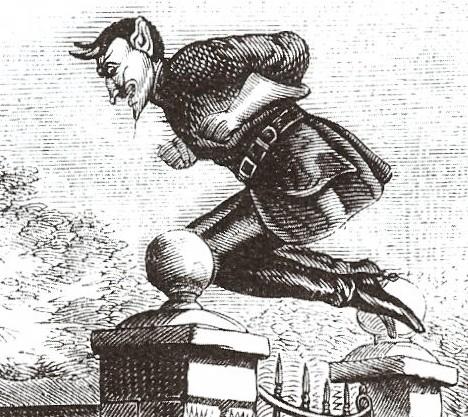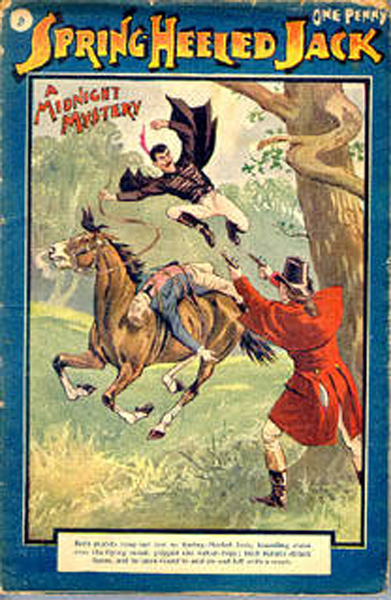English tradition enjoys a rich history of myths, ghost stories, and legends. Mystical villains and heroes established in popular stories reveal the flights of fancy of a specific historical period. Some of the characters of these stories, such as Sawney Bean, the Loch Ness Monster, or the Beast of Bodmin, still capture the imagination of today’s readers and listeners.
The Victorian era is commonly referenced as the age of reason and science, but this was also a period in which belief in supernatural creatures and practices became widespread. A most intriguing Victorian urban myth is that of the terrifying flying man called Spring-Heeled Jack.
The legend of Spring-Heeled Jack is recorded across England, from London to Liverpool. However, its origins are related to the area of Barnes Common (London) in the early 19th century with the appearance of a ghostly white bull. Before Spring-Heeled Jack had established his individuality, the character evolved from a bull to an imp, and later to an inhuman-like warrior in brass armor with sharp claws.

This inconsistency of character derived from the way the story was retold orally across the country, each of the storytellers embellishing the story, until 1838, when the metropolitan press finally announced the catchy name of Spring-Heeled Jack. This marked his position as a memorable figure in the Victorian folklore tradition.

Descriptions of Jack’s appearance vary, but his noticeable features were his tall, thin build with bat-like wings, pointed ears, horns, clawed hands, goatee beard, and wheels of fire for eyes that flashed in the dark night.The first recorded description of this particular character was formulated as “devil-like” by the attacked Polly Adams, a farmer’s daughter who worked in a London pub. Polly’s description was given by another woman in a Clapham churchyard who claimed to have seen a strange figure that escaped with huge leaps.

Some illustrations in the popular Penny Dreadfuls magazines presented him as a Spanish version of the Devil. The witnesses described him as utterly horrifying but also very agile, as after petrifying them in dark alleys or graveyards he could easily vanish by leaping over walls and rooftops and across hedges. Sometimes the horror didn’t end so quickly, and Jack physically attacked his victims who were, interestingly, mostly young women.

In February 1838, Jane Alsop was attacked by what she described as a devilish creature with fiery eyes and iron claws with which he scratched her before he leaped away in the dark night. Soon after, a girl named Lucy Scales and her sister were walking home through Green Dragon Alley in Limehouse when they “met” Jack. The sister later reported that he leaped from the rooftop and spat fumes into Lucy’s eyes, thus blinding her, only to peacefully walk away when her sister called for help. The same year, the Lord Mayor, Sir John Cowan, received a letter from a resident who reported an attack of the so-called Spring-Heeled Jack. The Lord Mayor published the letter, thus triggering other frightened individuals to report their own beastly encounters with Jack.

According to the BBC, in the following decades there were a number of reports, as well as denials, of encounters with Spring-Heeled Jack. Some people rumored to have seen him on the Tower of London and even scaling the spire of a London church. In 1855 he was seen in Old Hill, leaping from the roof of an inn to another roof across the road. There were other sightings of Jack outside of London during the 1880s, including at least one report in the Birmingham Post.
“First a young girl, then a man, felt a hand on their shoulder, and turned to see the infernal one with glowing face, bidding them a good evening.”

Regarding the validity of this urban legend, some theories suggest superstition as one of the main reasons for its circulation among people. Jack’s initial appearance was in urban areas. Considering that the 1830s was a period in Victorian Britain when huge numbers of people moved from the countryside into towns, it is understandable that these rural residents brought their old superstitions with them and transferred them to unfamiliar surroundings.

The image of Jack leaping on the roofs of pubs or churches was exploited by local preachers as an alarm against alcoholism. However, the lessons inspired by Jack extended even to troubled Victorian parents who found a new boogeyman that could assist in exhausting behavior management.
Parents told their troublesome children that if they didn’t behave, Jack would appear at the window of their bedroom at night and scare them while they slept. Some of the English elderly still remember being threatened with Jack if they refused to go to bed on time.
Spring-Heeled Jack’s final mention in the newspapers was in 1904 when the post reported having seen him jumping over a building in William Henry Street.
